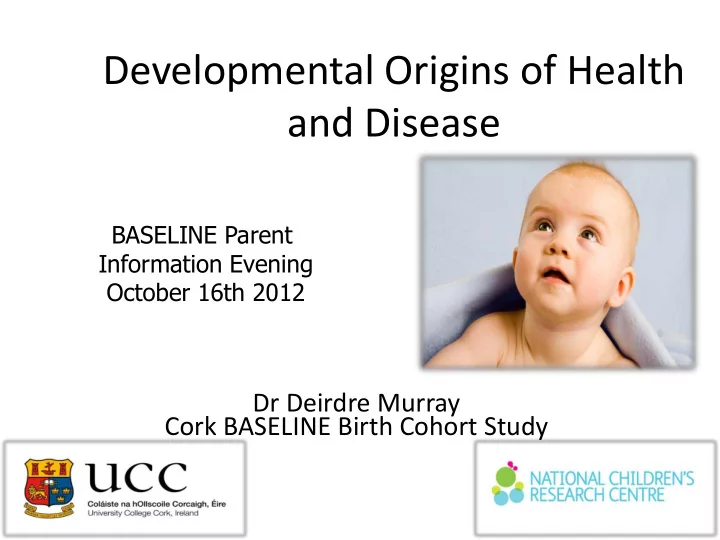

Developmental Origins of Health and Disease BASELINE Parent Information Evening October 16th 2012 Dr Deirdre Murray Cork BASELINE Birth Cohort Study
“ The most exciting phrase to hear in science, the one that heralds the most discoveries, is not "Eureka!" (I found it!) but 'That's funny... ” -Isaac Asimov Prof David Barker, Southampton University
Increasing wealth and nutrition associated with increasing rates of heart disease and obesity Low birth weight associated with highest rates
Dutch Famine 1944
Fetal growth High blood pressure High cholesterol Diabetes Polycystic ovaries Kidney disease
Theories Adult lifestyle Reduced nephrons Risk factors Hypertension Eg. obesity ESRF Altered structure/function of insulin-sensitive Target tissues Maternal genes & Environment Survival Adult disease In early life Maternal body composition Altered structure nutritional or stress And function of the endocrine hormone levels pancreas
Metabolic syndrome Obesity, hypertension, Polycystic ovaries Cardiovascular disease, Hypercholesterolaemia Type 2 diabetes End stage renal failure Stress Exercise Genetic predisposition Low birth weight Diet
National longitudinal survey 9 year old children in Ireland in 2009 19% overweight, 7% obese
Obesity in U.S. 9% at 3 years 30% at 5 years
5years 2500 Birth 2m 6m 12m 24m Feeding Growth Biobanking Body fat % TEWL Eczema,TEWL Body fat % Food allergy Anthropometry General health Neonatal course Childhood illness Developmental screening Intrauterine growth restriction Detailed neurodevelopment assessment BP, Insulin resistance, 25-OH-D3 Skin prick testing
The normal term newborn Mean Std. Dev n=996 G.A. at delivery (w) 39.75 1.15 Birthweight 3509.10 469.4 Head circumference 34.8 1.4 Length 50.4 2.0 Age (days) 1.83 .99 % body fat 11.18 5.13 Fat mass, kg .378 .172 Fat free mass, kg 2.951 .359 Fatlengthratio g/cm 7.45 3.27
Gestational Age Males Females P-Value 36-37 +6 wk 8.8 (3.2) 8.9 (3.8) 0.97 38-39 +6 wk 9.8 (3.9) 11.1 (3.9) 0.01 40-41 +6 wk 10 (3.9) 12.5 (4.4) <0.001 Total 9.8 (3.9) 11.9 (4.3) <0.001 Females have a greater proportion of body fat at each gestation Body fat is disproportionately accumulated relative to lean body mass at increasing term gestation
Results: Centile Chart Generated
• Females have more body fat than Males • Despite males having a greater birthweight • %Body fat increases with increasing gestation Hawkes CP, Pediatrics Sept 2011
Body Composition in small for gestational age babies August 2008 to February 2011 (n=1335) Body Fat composition, as measured by air displacement plethysmography was available for 66.7% (n=890) SGA babies 11.1% (n=148)
Distribution of Mean % Body Fat across the Customised Birthweight Quartiles n=890
Mean % Body Fat across the Gestational Ages 14 12 10 Mean % Body Fat 8 SGA FGR 6 AGA Non FGR Total Total 4 2 0 22-35+6 36-37+6 38-39+6 40-42+6 Gestational Age
Conclusion • Altered body composition in small infants (< 10 th BW centile) • Normal increase in %BF with gestational age does not occur in the SGA baby
Are the effects of growth restriction related to body fat at birth? Can we help to predict adult health?
Factors influencing early growth Maternal nutrition Baby ’ s nutrition Socioeconomic factors Blood pressure Cholesterol Insulin resistance Growth
Acknowledgements Thank you!
Recommend
More recommend